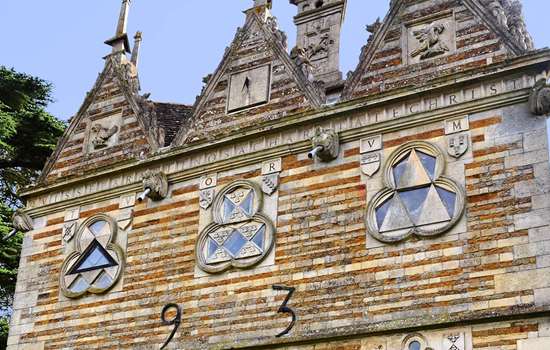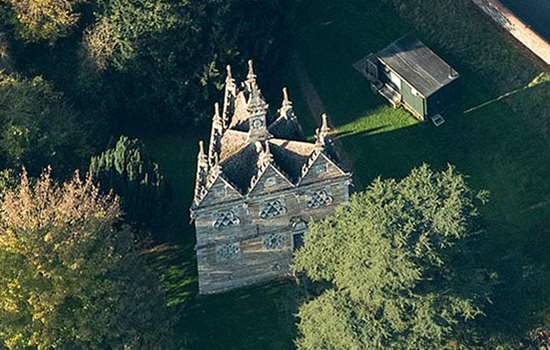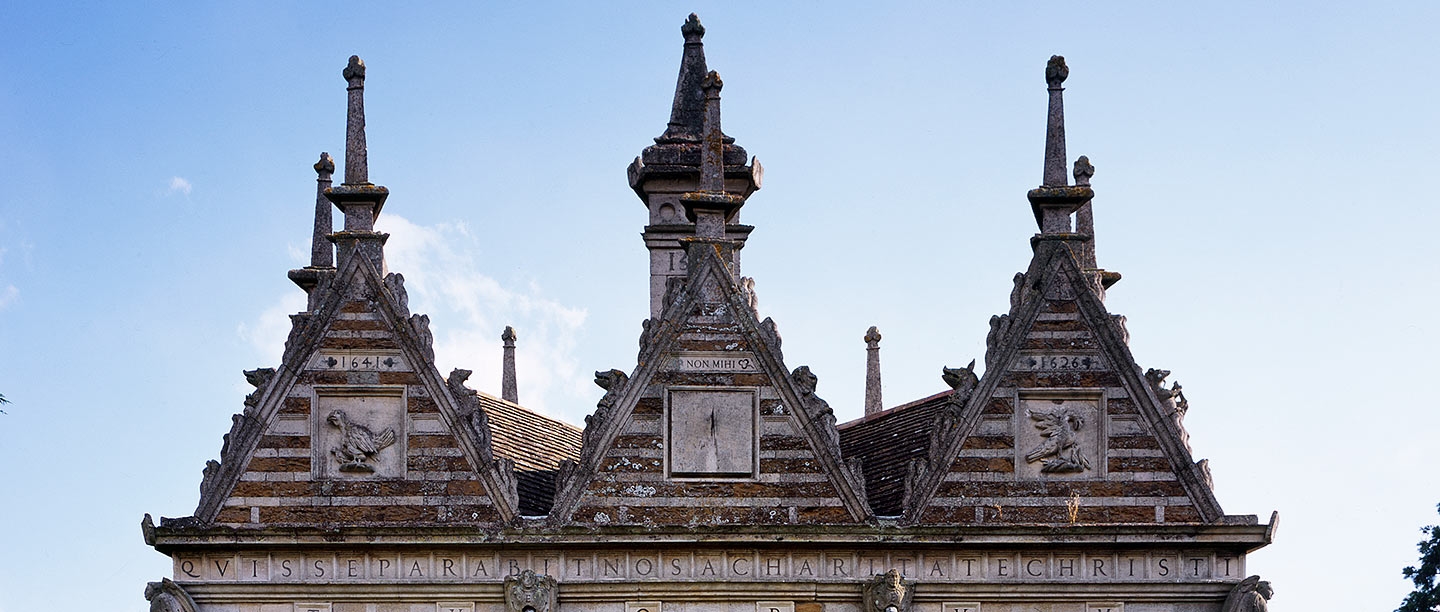The number three
The Triangular Lodge is a ‘device’ – a Tudor term for anything with secret and double meanings. It combines detailed knowledge of the Bible and its symbolism with imaginative patterns based on the number three, to make a bold and firm statement of faith.
It is most obviously an expression of the Holy Trinity, one god who is also three: the Father, the Son and the Holy Spirit. Expressions of the number three are evident in the plan and most of the details: the triangular shape; the three floors; three windows to a side on each floor; and three triangular gables on each side. Each of the sides measures 33 feet (10.2 metres) wide, 33 being the age at which Christ died on the cross.
Triangles and trefoils (leaves made up of three lobes) are apparent everywhere – in the shapes of the windows, the gables, the pinnacles and the chimney.
Devices in Elizabethan England
Elizabethans loved buildings, paintings and poems with hidden or several meanings. Such ’devices’ could be allegorical, have moral or political meaning, and feature codes or secret visual references. Many Tudor portraits featured sitters with symbolic objects, in places of significance, adopting postures, or wearing clothing and jewellery decorated with meaningful patterns or images.
To understand a device, the viewer had to be in the know and be prepared to puzzle it out. Aristocrats like Tresham were highly educated, well read, wrote fluently in Latin and had a detailed understanding of the Bible.
Devices could be created in architecture, as well as in art or literature, for the pleasure of residents and their guests. Tresham was probably the most notable builder of device houses, the Triangular Lodge being his first. On his Lyveden estate, he designed the cruciform Lyveden New Bield – with carvings referring to the Passion – as an expression of the Crucifixion of Christ.
Tresham had various books of emblems in his library and seemed to delight in their creation, even commissioning a painted window full of devices to adorn his room while imprisoned in Ely. He worked out its ciphers from Latin phrases on the back of letters from his wife, demonstrating his deep knowledge of the Bible.
Family pride
On the entrance front, the inscription – ‘Tres Testimonium Dant’ (‘there are three that give witness’) – is a quotation from St John’s Gospel, referring to the Trinity. But the use of the number three is also a pun on Tresham’s name. Muriel Tresham, his wife, called him ‘Good Tres’ in her letters, and his name’s alternative spelling, ‘Tresam’, means ‘I am three’ in Latin. The Trinity held both devotional and familial significance to the Treshams.
Pride in family was further celebrated by the inclusion of Tresham’s crest. A boar’s head holding a trefoil is on all the lower windows, together with his trefoil shield, which also appears above the entrance. Escutcheons (shields with coats of arms) feature the family crests or coats of arms of the Treshams and related families, with some left blank for future marriages.
Hidden meanings
Tresham did not leave an explanation of the Lodge’s symbolism, but a close study of the ornament reveals that it is not as innocent and playful as it first appears. While the Trinity was uncontroversial, the meaning of the Mass and its rituals was a source of profound disagreement between Protestants and Catholics. Celebrating the Catholic Mass was illegal, but many Catholics did so secretly, and Sir Thomas was accused of doing so on his estates.
One example of an outwardly innocent symbol is that of a dove feeding her young, in the left gable on the north front: this is a reference to the Virgin Mary, Catholic devotion to whom was frowned upon by Protestants. The chalice carved on the south-west side of the chimney represents the vessel containing the wine that, according to Catholic belief, is transformed literally into the blood of Christ during the Mass, thus offering ‘Salus’ (salvation) to those who imbibe it. Other symbols and words around the highest levels of the Lodge also clearly refer to the Catholic Mass.
You can explore the main elements of the Lodge’s decoration using the hotspots on the 3D image below.
Find out more
-

Visit Rushton Triangular Lodge
One of England’s strangest buildings, packed with secret codes.
-

History of Rushton Triangular Lodge
The story of the Lodge’s construction reveals the power and dangers of religion in Tudor England, the bonds of a family through persecution and treason, and Elizabethan delight in secret codes and symbols.
-

MORE HISTORIES
Delve into our history pages to discover more about our sites, how they have changed over time, and who made them what they are today.
